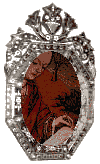| there
are two columns on this page. The left-hand column is the Column for
the Rubric Material. The right-hand column is for the text.
Column for Rubric Material **Threaded voices **General Navigation
|
Jorge Luis Borges No direct source of knowledge concerning the life of Marguerite Porete (also known as Marguerite of Hainaut) remains except for the extant copies of The Mirror of Simple Annihilated Souls (4), the record of her trial for heresy, and some testimony of spiritual men of her time. She is believed to have been a Beguine - a member of the women-only lay communities who took no vows but dedicated themselves to charity and the study of vernacular languages. Marguerite is credited with a translation of the Bible into Old French before she wrote the Mirror (Brunn and Epiney-Burgard 146). Her book was burned in the public square at Valenciennes in 1306, and its use was prohibited under pain of excommunication, but she went on distributing it. Twice arrested for heresy, she refused to recant or to explain her philosophies. On May 31, 1310, she was declared to be a relapsed heretic. On June 1, 1310, she was burned at the stake on the Place de Greve in the presence of civil and ecclesiastical authorities. The crowd was won over to her favor by her serenity in the face of death. Yet, this outcome might not have come as a surprise. Although she was one of the first women mystics to be executed, she was surely aware of the tenor of the Church in those years. The schism had diminished the actual power of the clergy, resulting in the adoption of new practices. Heresy had long been a serious offense, but in the years preceding Marguerite's trial, the clergy had decided to be responsible for witchcraft and sorcery as well. This policy added to the confusion and brutality surrounding King Philip the Fair's persecution of the Knights Templar, for example, in 1307-1312. Marguerite quietly insisted on the truth of her revelations, regardless. "Far from ceasing with Marguerite's death, the persecutions by the Inquisition continued and may be said to bear witness to the success of Mirror in Europe in the fourteenth and fifteenth centuries. It overcame linguistic barriers as did no other contemporary mystical writing in the vernacular [. . . .] 'With the condemnation of Vienne, the Mirror is henceforth labeled as a heretical work and was regularly confiscated by the Inquisitional authorities of the whole of Europe until the Renaissance, an eloquent proof of its success and diffusion.'" (Brunn and Epiney-Burgard 147) "The first English version of the Mirror, dated fourteenth century, is in all probability the work of Michael of Northbrook, Bishop of London and co-founder of the London Charterhouse. As this text became an object of criticism, many years later he rewrote his translation, adding to it orthodox glosses." (Brunn and Epiney-Burgard 148) Her ideas continued to be controversial for centuries. Translations, copies, and summaries of Marguerite's Mirror circulated either anonymously or as male-authored until 1946. One of the central tenets of the Mirror is that annihilation of the will is a form of freedom. "When I expressed these precious
unspeakable things, The Mirror of Simple Annihilated Souls. (Brunn and Epiney-Burgard 161) Further information on Marguerite of Hainaut (5) Recto / Permanence / Impermanence / Alteration / Obsolescence / Obliteration / Verso
|
 Marguerite
of Hainaut
Marguerite
of Hainaut